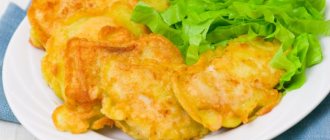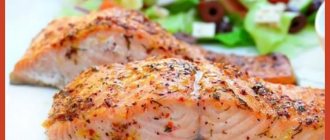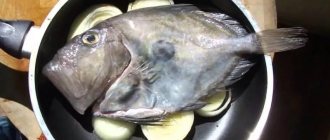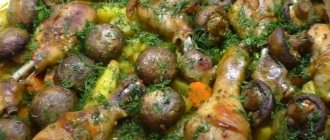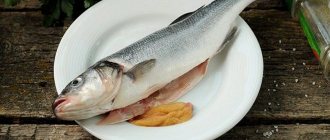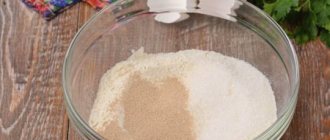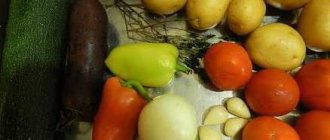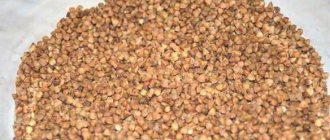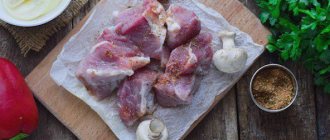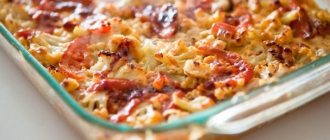Good day, dear guests of our site! Today we will prepare a very simple and tasty dish - fish in an omelet.
When I was a child, such fish was always on the kindergarten menu. Most often, this dish was served at lunch. The casserole was very tasty and it is not surprising that it was eaten instantly, and someone even asked for more.
In our family, fish in an omelet is also often prepared. This dish can be served with mashed potatoes or as a meal on its own. The fish turns out juicy and tasty, and the cooking process does not take much time. This casserole can be prepared in a frying pan, in a slow cooker, in the microwave or oven. It is the last option that we will focus on.
Fish in an omelet like in kindergarten
List of required ingredients:
- Fish fillet (boneless) - 500 g;
- Chicken eggs - 3 pcs;
- Milk - 100 ml;
- Wheat flour - 1 tbsp;
- Salt - 1/2 tsp.
How to cook fish in an omelet like in kindergarten:
1. Wash the fillet and place it on a paper towel to remove excess water. Then, cut into small pieces. The fish must be without bones!
2. Place the chopped fish in a frying pan and pour in about 100 ml of water. Add salt, bring to a boil and simmer for about 5 minutes under the lid.
3. Grease the mold well with butter and lay out the fish.
4. Combine chicken eggs with milk and whisk until smooth.
5. Add a tablespoon of flour and a pinch of salt. Mix everything thoroughly, making sure that there are no lumps left.
6. Pour the resulting mixture over the fish and level the surface.
7. Place in an oven preheated to 200º and bake for about 25 minutes. Bon appetit!
If desired, you can add ground black pepper and other seasonings.
How to deliciously fry pollock with onions so that it is juicy and soft
Fish prepared according to this recipe will amaze you with its juiciness, tenderness and aroma.
We will need:
- Pollock - 900 grams,
- Onion – 2 large onions,
- Butter – 35 grams,
- Bay leaf - 3 pieces,
- Black pepper – 10 peas,
- Allspice - 3 peas,
- Salt - to taste
Let's start cooking. First of all, prepare the fish. We already have pollock without a head and gutted.
Therefore, we just cut off the fins and tail, remove the black film, and clean the scales. The peculiarity of pollock is that it has very small scales that are easy to clean, sometimes even brushing is enough. We wash the fish, dry it with a towel to remove excess water and cut it into portions.
Add butter to the frying pan and immediately add a lot of onions, and literally after 2-3 minutes we fix the fish.
It is important that the oil does not boil, but simmers, then the onion and fish will exchange their aromas.
We take out the onion from below and cover the entire fish. Cover the pan with a lid and let simmer for 10-15 minutes.
After the required time has passed, open the lid and very carefully turn the pollock over to the other side. Our fish is stewed in the juice from onions and butter for another 10-15 minutes.
Just 30 minutes in the pan, and we get soft, tender, aromatic, juicy fish. Try it, you won't regret it. The taste is amazing.
Fish in an omelet with cheese
List of required ingredients:
- Sea fish fillet (boneless) - 500 g;
- Chicken eggs - 4 pcs;
- Milk - 100 ml;
- Wheat flour - 1 tbsp;
- Cheese - 150 gr;
- Salt, pepper - to taste;
- Fresh dill - optional.
How to cook fish in an omelette with cheese:
1. Wash the fillet and dry it with a paper towel. Then, cut into pieces 1.5-2 cm wide.
2. In a small saucepan or deep frying pan, bring 100-150 ml of water to a boil and drop the fish pieces into it. Add about 0.5 tsp. salt and simmer the fish for 5-7 minutes over medium heat under the lid.
3. In a deep bowl, beat eggs and milk. Then add flour, salt and pepper to taste. Mix everything thoroughly until a homogeneous mass without lumps is obtained.
4. Now, place the finished fish into the resulting mass, mix gently and place in a greased form.
5. Place in an oven preheated to 200º and bake for about 25 minutes. 5 minutes before it’s ready, take the casserole out of the oven, sprinkle with grated cheese and fresh dill. Place in the oven again and bake for the remaining time. Bon appetit!
To prepare such a casserole, sea fish with few bones are suitable: pollock, tilapia, hake, haddock, etc.
Delicious and juicy pollock in tomato sauce in a frying pan - step-by-step cooking at home
The fish turns out incredibly tasty, everyone likes it, and it’s very easy to prepare.
Required ingredients:
- Cleaned pollock – 450 grams,
- Onion – 1 piece,
- Carrots – 1 piece,
- Tomato juice – 250 ml,
- Vegetable oil - for frying,
- Flour for deboning fish
Step 1 Cut the fish into pieces and place in a deep container. Salt, add black pepper, mix and leave to marinate for 10 minutes. If you like fish seasoning, you can add it, but be careful not to oversalt it. Remember that most seasonings already contain salt.
Step 2 While it is marinating, prepare the vegetables. Cut the onion into large cubes and fry in a frying pan for 1 minute.
Step 3 Add the carrots, grated on a coarse grater, to the onion and fry for another 2 minutes.
Step 4 Then add a glass of tomato juice to the vegetables. If there is no juice, then you can dilute 2 tablespoons of tomato paste in a glass of water and add it to the frying pan.
Step 5 We dilute one tablespoon of sour cream in half a glass of water, add it to our sauce and simmer everything together for a couple of minutes.
Step 6 While the sauce is preparing, roll the pollock pieces in flour.
Step 7 We send our pollock to the tomato sauce. After ten minutes, turn the fish over and simmer for 10-15 minutes over low heat.
The fish is well cooked and turns out juicy, tender and very tasty. Due to the presence of flour and vegetables, an excellent gravy is obtained.
You can serve it with any side dish, but I prefer fish with mashed potatoes.
Fish in an omelet with vegetables
List of required ingredients:
- Pollock fillet - 500 g;
- Carrots - 1 large or 2 small;
- Onions - 2 pcs;
- Chicken eggs - 4 pcs;
- Milk - 100 ml;
- Fresh dill - 50 g;
- Salt, pepper - to taste.
How to cook fish in an omelet with vegetables:
1. Peel the carrots and onions. Grate the carrots on a coarse grater and cut the onion into cubes.
2. Pour a little vegetable oil into the frying pan and fry the vegetables over medium heat for about 7-8 minutes, stirring occasionally.
3. Wash the fish and dry it with a paper towel. Then, cut into pieces 2-3 cm wide.
4. In a saucepan or deep frying pan, bring 150 ml of water to a boil. Dip the fish pieces into boiling water and add about 0.5 tsp. salt. Cover with a lid and simmer over medium heat for 5-7 minutes.
5. In a separate container, beat eggs and milk. Then add flour, salt and pepper to taste. Mix everything thoroughly, making sure that there are no lumps left. After this, add fresh dill.
6. Grease the mold with butter. Place half of the fried vegetables and pour in 1/3 of the egg-milk mixture. Next, distribute the fish evenly. Place the second part of the fried vegetables on top and pour in the remaining egg-milk mixture.
7. Place the casserole in an oven preheated to 200º and bake for 25-30 minutes until cooked. Bon appetit!
In addition to carrots and onions, you can add other vegetables, such as tomatoes and bell peppers
Pollock recipe in omelet. Calorie, chemical composition and nutritional value.
Nutritional value and chemical composition of “Pollock in an omelet.”
The table shows the nutritional content (calories, proteins, fats, carbohydrates, vitamins and minerals) per 100 grams of edible portion.
| Nutrient | Quantity | Norm** | % of the norm in 100 g | % of the norm in 100 kcal | 100% normal |
| Calorie content | 100.8 kcal | 1684 kcal | 6% | 6% | 1671 g |
| Squirrels | 12.4 g | 76 g | 16.3% | 16.2% | 613 g |
| Fats | 4.7 g | 56 g | 8.4% | 8.3% | 1191 g |
| Carbohydrates | 2.2 g | 219 g | 1% | 1% | 9955 g |
| Alimentary fiber | 0.4 g | 20 g | 2% | 2% | 5000 g |
| Water | 79.7 g | 2273 g | 3.5% | 3.5% | 2852 g |
| Ash | 1.21 g | ~ | |||
| Vitamins | |||||
| Vitamin A, RE | 73.1 mcg | 900 mcg | 8.1% | 8% | 1231 g |
| Retinol | 0.063 mg | ~ | |||
| beta carotene | 0.019 mg | 5 mg | 0.4% | 0.4% | 26316 g |
| Vitamin B1, thiamine | 0.071 mg | 1.5 mg | 4.7% | 4.7% | 2113 g |
| Vitamin B2, riboflavin | 0.17 mg | 1.8 mg | 9.4% | 9.3% | 1059 g |
| Vitamin B4, choline | 94.82 mg | 500 mg | 19% | 18.8% | 527 g |
| Vitamin B5, pantothenic | 0.434 mg | 5 mg | 8.7% | 8.6% | 1152 g |
| Vitamin B6, pyridoxine | 0.111 mg | 2 mg | 5.6% | 5.6% | 1802 |
| Vitamin B9, folates | 6.801 mcg | 400 mcg | 1.7% | 1.7% | 5881 g |
| Vitamin B12, cobalamin | 1.197 mcg | 3 mcg | 39.9% | 39.6% | 251 g |
| Vitamin C, ascorbic acid | 0.91 mg | 90 mg | 1% | 1% | 9890 g |
| Vitamin D, calciferol | 0.601 mcg | 10 mcg | 6% | 6% | 1664 g |
| Vitamin E, alpha tocopherol, TE | 0.365 mg | 15 mg | 2.4% | 2.4% | 4110 g |
| Vitamin H, biotin | 4.181 mcg | 50 mcg | 8.4% | 8.3% | 1196 g |
| Vitamin K, phylloquinone | 0.1 mcg | 120 mcg | 0.1% | 0.1% | 120000 g |
| Vitamin RR, NE | 4.057 mg | 20 mg | 20.3% | 20.1% | 493 g |
| Niacin | 0.755 mg | ~ | |||
| Macronutrients | |||||
| Potassium, K | 249.37 mg | 2500 mg | 10% | 9.9% | 1003 g |
| Calcium, Ca | 59.11 mg | 1000 mg | 5.9% | 5.9% | 1692 g |
| Magnesium, Mg | 31.09 mg | 400 mg | 7.8% | 7.7% | 1287 g |
| Sodium, Na | 179.08 mg | 1300 mg | 13.8% | 13.7% | 726 g |
| Sera, S | 158.68 mg | 1000 mg | 15.9% | 15.8% | 630 g |
| Phosphorus, P | 166.4 mg | 800 mg | 20.8% | 20.6% | 481 g |
| Chlorine, Cl | 365.33 mg | 2300 mg | 15.9% | 15.8% | 630 g |
| Microelements | |||||
| Aluminium, Al | 63.7 mcg | ~ | |||
| Bor, B | 26.8 mcg | ~ | |||
| Iron, Fe | 1.053 mg | 18 mg | 5.9% | 5.9% | 1709 |
| Yod, I | 106.73 mcg | 150 mcg | 71.2% | 70.6% | 141 g |
| Cobalt, Co | 12.961 mcg | 10 mcg | 129.6% | 128.6% | 77 g |
| Manganese, Mn | 0.1132 mg | 2 mg | 5.7% | 5.7% | 1767 |
| Copper, Cu | 118.09 mcg | 1000 mcg | 11.8% | 11.7% | 847 g |
| Molybdenum, Mo | 5.26 mcg | 70 mcg | 7.5% | 7.4% | 1331 g |
| Nickel, Ni | 5.092 mcg | ~ | |||
| Tin, Sn | 3.02 mcg | ~ | |||
| Rubidium, Rb | 63.8 mcg | ~ | |||
| Selenium, Se | 17.293 mcg | 55 mcg | 31.4% | 31.2% | 318 g |
| Strontium, Sr | 3.42 mcg | ~ | |||
| Fluorine, F | 488.25 mcg | 4000 mcg | 12.2% | 12.1% | 819 g |
| Chromium, Cr | 38.32 mcg | 50 mcg | 76.6% | 76% | 130 g |
| Zinc, Zn | 1.1698 mg | 12 mg | 9.7% | 9.6% | 1026 g |
| Digestible carbohydrates | |||||
| Starch and dextrins | 0.013 g | ~ | |||
| Mono- and disaccharides (sugars) | 2.2 g | max 100 g | |||
| Glucose (dextrose) | 0.174 g | ~ | |||
| Sucrose | 0.871 g | ~ | |||
| Fructose | 0.161 g | ~ | |||
| Essential amino acids | 0.038 g | ~ | |||
| Arginine* | 0.851 g | ~ | |||
| Valin | 0.762 g | ~ | |||
| Histidine* | 0.339 g | ~ | |||
| Isoleucine | 0.863 g | ~ | |||
| Leucine | 1.096 g | ~ | |||
| Lysine | 1.395 g | ~ | |||
| Methionine | 0.488 g | ~ | |||
| Methionine + Cysteine | 0.65 g | ~ | |||
| Threonine | 0.731 g | ~ | |||
| Tryptophan | 0.177 g | ~ | |||
| Phenylalanine | 0.606 g | ~ | |||
| Phenylalanine+Tyrosine | 1.108 g | ~ | |||
| Nonessential amino acids | 0.089 g | ~ | |||
| Alanin | 0.754 g | ~ | |||
| Aspartic acid | 1.061 g | ~ | |||
| Glycine | 0.626 g | ~ | |||
| Glutamic acid | 1.258 g | ~ | |||
| Proline | 0.487 g | ~ | |||
| Serin | 0.66 g | ~ | |||
| Tyrosine | 0.503 g | ~ | |||
| Cysteine | 0.161 g | ~ | |||
| Sterols (sterols) | |||||
| Cholesterol | 153.07 mg | max 300 mg | |||
| Saturated fatty acids | |||||
| Saturated fatty acids | 2 g | max 18.7 g | |||
| 4:0 Oil | 0.063 g | ~ | |||
| 6:0 Kapronovaya | 0.014 g | ~ | |||
| 8:0 Caprylic | 0.012 g | ~ | |||
| 10:0 Kaprinovaya | 0.032 g | ~ | |||
| 12:0 Lauric | 0.041 g | ~ | |||
| 14:0 Miristinovaya | 0.146 g | ~ | |||
| 15:0 Pentadecane | 0.002 g | ~ | |||
| 16:0 Palmitinaya | 0.891 g | ~ | |||
| 17:0 Margarine | 0.006 g | ~ | |||
| 18:0 Stearic | 0.323 g | ~ | |||
| 20:0 Arakhinovaya | 0.006 g | ~ | |||
| Monounsaturated fatty acids | 1.555 g | min 16.8 g | 9.3% | 9.2% | |
| 14:1 Myristoleic | 0.014 g | ~ | |||
| 16:1 Palmitoleic | 0.153 g | ~ | |||
| 17:1 Heptadecene | 0.002 g | ~ | |||
| 18:1 Oleic (omega-9) | 1.256 g | ~ | |||
| 20:1 Gadoleic (omega-9) | 0.008 g | ~ | |||
| Polyunsaturated fatty acids | 0.543 g | from 11.2 to 20.6 g | 4.8% | 4.8% | |
| 18:2 Linolevaya | 0.242 g | ~ | |||
| 18:3 Linolenic | 0.02 g | ~ | |||
| 20:4 Arachidonic | 0.04 g | ~ | |||
| Omega-3 fatty acids | 0.1 g | from 0.9 to 3.7 g | 11.1% | 11% | |
| 22:4 Docosatetraenoic acid, Omega-6 | 0.121 g | ~ | |||
| 22:6 Docosahexaenoic acid (DHA), Omega-3 | 0.127 g | ~ | |||
| Omega-6 fatty acids | 0.3 g | from 4.7 to 16.8 g | 6.4% | 6.3% |
The energy value of pollock in an omelet is 100.8 kcal.
Primary Source: Created in the application by the user. Read more.
** This table shows the average levels of vitamins and minerals for an adult. If you want to know the norms taking into account your gender, age and other factors, then use the “My Healthy Diet” application.
Fish in an omelet with tomatoes
List of required ingredients:
- Pink salmon fillet - 500 g;
- Tomatoes - 2 -3 pcs;
- Chicken eggs - 3 pcs;
- Milk - 100 ml;
- Flour - 1 tbsp;
- Cheese - 200 gr;
- Salt, pepper - to taste.
How to cook fish in an omelet with tomatoes:
1. Clean the pink salmon and rinse it well. Then, wipe with a paper towel and separate the fillet from the bones. After this, cut the fillet into pieces 2-3 cm wide
2. Pour 150 ml of water into a deep frying pan and bring to a boil. Place the fish in boiling water and add 0.5 tsp. salt and simmer covered for about 5 minutes.
3. Grease the mold with butter and distribute the finished fish evenly. Then, lay out the tomatoes cut into slices.
4. Beat eggs with milk. After this, add flour, salt and pepper to taste, mix everything well. Make sure there are no lumps left.
5. Pour the resulting mixture over the fish and tomatoes. Sprinkle grated cheese on top.
6. Place in an oven preheated to 200º for 20-25 minutes. Bon appetit!
Pink salmon can be replaced with other fish, as long as there are no bones in it
Pollock in a frying pan with vegetables - the most delicious recipe
I suggest cooking fish with vegetables. By itself, pollock meat has a neutral taste, but when mixed with the aroma of onions, carrots and peppers it becomes fabulously tasty. Pollock prepared according to this recipe turns out amazing. It only takes 15 minutes to prepare if all the necessary ingredients are prepared.
We will need:
- Pollock fillet – 400 grams,
- Onions – 2 pieces (200 grams),
- Carrots – 1 piece (250 grams),
- Sweet pepper – 1 piece (100 grams),
- Bay leaf – 1 piece,
- Ground black pepper,
- Salt
Defrost the pollock fillet at room temperature and cut it into large portions. If we only have frozen pollock, then we defrost it, clean it and fillet it.
We wash all the vegetables well, let the water drain and chop them coarsely: onions into half rings, carrots into slices, peppers into squares.
First, fry the onion for just 1 minute. Then mix and add carrots and peppers. Fry for 1 minute.
The peculiarity of preparing this dish is that everything is cooked over high heat with regular stirring of the food so that it does not burn.
Then sprinkle with ground black pepper, add bay leaf, lay out the fish and fry everything again over high heat for 5 minutes.
Make sure that the vegetables and fish do not burn; do not forget to stir them constantly.
At the very end, add salt to taste. That's it, the pollock with vegetables is ready.
Fish in an omelet with potatoes
List of required ingredients:
- Potatoes - 5-6 pcs;
- Fish (boneless fillet) - 500 g;
- Carrots - 1 piece;
- Onion - 1 piece;
- Eggs - 4 pcs;
- Milk - 100 ml;
- Flour - 1 tbsp;
- Cheese - 150 gr;
- Salt, pepper - to taste.
How to cook fish in an omelet with potatoes:
1. Peel the potatoes, cut into slices about 3 mm wide and cover with cold water.
2. Wash the fish, dry it with a paper towel and cut into pieces 2-3 cm wide.
3. In a deep frying pan, bring 150 ml of water to a boil, and then lower the fish into it. Add 0.5 tsp. salt and simmer for about 5-7 minutes.
4. Grate the carrots on a fine grater, cut the onion into small cubes and crush with your hand to release the juice.
5. Grease the mold with butter and lay out half the potatoes. Salt and pepper to taste, then evenly distribute the carrots and onions.
6. Combine eggs and milk using a whisk. Then add flour and a pinch of salt.
7. Pour 1/3 of the filling onto the potatoes, carrots and onions.
8. Now, distribute the fish evenly. And behind it are potatoes.
9. Salt and pepper to taste and pour out the remaining filling.
10. Sprinkle the surface with grated cheese and place in an oven preheated to 200º for 30-35 minutes. Bon appetit!
If desired, in addition to salt and pepper, you can add other seasonings, as well as fresh herbs.
Pollock in a frying pan in sour cream with carrots and onions
Fish prepared according to this recipe will delight you not only with its delicate taste, but also with its bright, beautiful appearance. This dietary dish is very easy to prepare.
To prepare we will need:
- Pollock – 1 kilogram,
- Sour cream – 300 grams,
- Onion – 1 piece (100 grams),
- Carrots – 1 piece (120 grams),
- Vegetable oil - for greasing the pan,
- Salt, pepper - to taste
First of all, prepare the fish. We cut off the head, remove the entrails, cut off the fins, clean and rinse it well, and be sure to remove the black film.
Pollock scales are small and easy to clean, and do not fly in all directions like other fish. Cut the pollock into portions, add salt and pepper to taste and set aside to marinate.
The treat will be tastier if the fish is well marinated; you can add dried herbs for piquancy.
While the fish is marinating, prepare the vegetables. Peel the onions and carrots, rinse in cold water and chop. Cut the onion into small pieces, grate the carrots on a grater with a medium blade.
Now let's collect our fish. Grease a frying pan with vegetable oil and place chopped onion, grated carrots and fish on it in layers. Add some warm water.
Don't forget to add water, otherwise your dish may burn.
However, do not overdo it with water, because sour cream will also give liquid. If there is excess moisture, the fish will cook and not stew, but we don’t need that.
Top the pollock with sour cream of any fat content, but it is better to use 20% sour cream.
Thanks to sour cream with twenty percent fat content, the dish will be more juicy and satisfying. If the ingredient is low-fat, the fish may turn out dry.
Close the lid and leave to simmer over moderate heat for 30 minutes. The main thing is that the carrots become soft. This time is enough to cook tender fish.
When serving, you can pour the juice obtained from stewing over the dish.
Admire what we came up with.
Pollock in a potato coat
Required ingredients:
- Pollock fillet - 500 g;
- Potatoes - 3 pcs. medium size;
- Chicken egg - 1 piece;
- Wheat flour - 2 tbsp for batter and 1 tbsp. for deboning;
- Dry ground garlic - 1 tsp;
- Salt, pepper and spices - to taste.
Preparation:
1. Rinse the fish fillet and dry well with a paper towel. Next, add salt and pepper to taste, sprinkle with lemon juice if desired and set aside for 30 minutes.
2. Peel the potatoes and grate them on a coarse grater, add 1 egg, dry ground or fresh chopped garlic, 2 tbsp. flour, salt and pepper to taste and mix everything well.
3. Roll the fillet pieces in flour on all sides and spread a thin layer of batter onto the fish with a spoon or hand, then turn it over and place the batter on the other side. The fillet pieces should be completely and evenly coated with batter.
4. Fry the fish in heated vegetable oil on both sides until golden brown.
The fish is ready. Bon appetit!
In mayonnaise batter
When preparing batter with mayonnaise, you should taste it before adding salt. The fact is that it is part of the sauce, and if you add salt to the batter, as usual, you can get an inedible dish. To work you will need:
- 3 eggs;
- 120 g mayonnaise;
- 10 ml lemon juice;
- suitable seasonings;
- paprika;
- curry.
Sequencing:
- Beat eggs with mayonnaise, and then pour in lemon juice.
- Pour seasonings into the batter, add salt if necessary and stir.
- Gradually adding flour, bring the dough to the desired viscosity.
- If you have fresh herbs in the refrigerator, you can add them to the fish batter by finely chopping them with a knife.
Pollock fritters
Required ingredients:
- Pollock fillet - 600-700 g;
- Chicken eggs - 2 pcs;
- Milk - 1 glass;
- Wheat flour - 1 cup;
- Salt and sugar 1 tsp each;
- Soda - 1/4 teaspoon.
Preparation:
1. Pour cold water over the fish fillet for 30 minutes. Then drain the water, rinse the fish and squeeze or dry with a paper towel.
2. Cut the fillet with a knife into small pieces of about 0.5-1 cm. In this case, be sure to remove all the bones that come across.
3. Break 2 eggs into a bowl, add sugar, salt, soda, pour in milk and mix well. Then add pre-sifted flour and mix until the consistency of liquid sour cream is uniform.
4. Add chopped fish to the resulting batter and mix thoroughly.
5. Heat vegetable oil in a frying pan and add pancakes using a spoon. Fry until golden brown on each side for about 3-4 minutes over medium heat.
6. Place the finished pancakes on a plate lined with a paper towel to drain off excess oil.
The fish is ready. Bon appetit!
Step-by-step recipe with photos
The main character of the declared dish is the well-known pollock. The fish must be cleaned of internal films, then the fins must be cut off and the scales removed. Cut each carcass into portions. We will not remove the bones, this way the pieces will be intact. If the dish is being prepared for children or for a holiday dinner, you can use fillet.
Bread each piece of fish in flour to which salt has been added.
On the stove, preheat a frying pan with a small amount of oil. Place the prepared fish for frying. Please note that there is empty space between the pieces: the omelette will be poured here later.
